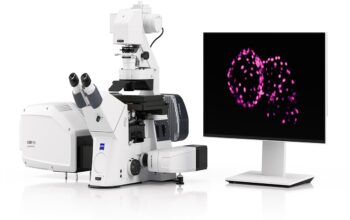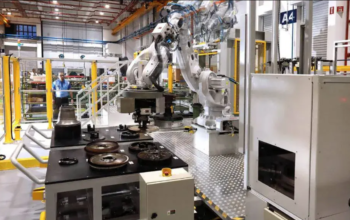The aerospace research center METALLICADOUR applies optical measurement to validate new manufacturing techniques for automation & defect detection.
This content was originally written and published by the Bruker Alicona team on their website. Reproduced from here.
Automated measurements along with repeatable and traceable 3D measurement data convinced the technology transfer center Metallicadour to choose Alicona. For developing an innovative tool and automated machining solutions in aerospace applications, they verify geometric dimensions and surface finish on tools and components using optical 3D metrology.

Pierre Courbun,
Development Engineer at Metallicadour
“Cutting tools for machining aerospace components have to meet the highest precision requirements for high-speed machining. Therefore, geometry and edge conditions need to be addressed. With Alicona we found what we were looking for: A measurement solution that provides us with precise, repeatable measurements as well as simplicity and flexibility in use.”
Use of optical 3D measurement to meet increasing demands in tooling
New applications in the aerospace industry and the rapid pace of technological change lead to an increasing demand in tooling. With Alicona’s optical measurement technology, the expert team at Metallicadour found the right solution for measuring complex geometries and hard-tomachine materials, such as titanium, composites and heat-resistant alloys.
Test and automate machining processes
Metallicadour is a resource and technology transfer center devoted specifically to the metal industry and fields of machining, assembly and process automation. It was founded in 2015 with the academic support of ENIT, the National School of Engineering in Tarbes in France. The center is located in the heart of the Adour Industrial Basin in France and aimed particularly at SMEs in aeronautics. The center is supported in its work by the major local aircraft manufacturers, among them Safran, Daher and Dassault. Metallicadour enables component manufacturers to test and automate machining processes and demonstrate the interest in new cutting technologies, such as very high pressure lubrication and cryogenic turning.

Improved surface finish of components
Verification of form and roughness has a major influence on the service life of a tool and can help to significantly reduce wear and chatter for an improved surface finish of components. “Cutting tools for machining aerospace components have to meet the highest precision requirements for high-speed machining. Therefore, geometry and edge conditions need to be addressed”, Pierre Courbun, Development Engineer at Metallicadour explains, “With Alicona we found what we were looking for: A measurement solution that provides us with precise, repeatable measurements as well as simplicity and flexibility in use.”
“We also measure roughness on parts that are too small to be measured tactile!”
As the measured parts and requirements vary, Courbun and his colleagues were pleased to find a solution for all kinds of measurement tasks, including form and roughness measurement of mills, inserts and drills. Pierre Courbun: “Our components often show steep flanks, deep lengths and light refection. With Alicona’s optical measurement system, we measure small surface connection radii and the geometry of very complex surfaces. We are also able to verify roughness on components with very smooth surfaces or parts that are way too small to be measured tactile. Laser solutions are often not precise enough for our measurement tasks.”
Roughness is measured profile based and area-based
Based on the technology of Focus-Variation, the measurement system allows for profile (Ra, Rq, Rz) and area-based measurements (Sa, Sq, Sdr). With up to 500 million measurement points it provides robustness of the measurement data. Accuracy of roughness measurements can be verified with a roughness standard that is traceable back to the PTB (National Metrology Institute of Germany).

Correlation between cutting forces, wear behavior and tool performance
The 3D measurements can be compared against CAD data or reference geometries for verification of accuracy. This helped Courbun and his partners in their research on understanding the cutting phenomenon and related indicators: “With our measurements we compare different tools and materials to investigate wear behaviour. We study the correlation between cutting forces, wear behaviour and performance of the tool, respectively the roughness generated by the tool over its full life cycle. Moreover, we also investigate the links to the matter of surface material as well as the change of mechanical surface tension”.
Optical metrology sensor combined with robotics

Alicona is also used in the development of new machining solutions. Courbun continues: “We are working on an automated manufacturing solution, where the workpiece is processed by a milling robot. Following each process step, the component is automatically measured for verification of dimensions and possible deviations from the target geometry. This is implemented by another robot that is equipped with Alicona’s optical sensor. Based on the high-resolution measuring data, the machine automatically modifies the process parameters for further manufacturing.”
Automated defect measurement of aircraft components
In joint research and development projects, Metallicadour and Alicona also implemented automated defect measurement on rotor blades as well as new collaborative robot solutions (Cobots) for quality control of landing gears, turbine discs and large components. Defects on rotor blades as well as engine and other aircraft components are safety-critical when they cause stress points which in turn create a crack. When the local stress concentration becomes too high or the crack reaches a critical size, the remaining material cannot support the applied loads. This may result in a fracture or sudden rupture. The defects can be caused by machining errors, corrosion or external influence, i.e. the impact of stones and debris. “Before, components could only be evaluated by the unaided eye of an expert.
With Alicona local surface defects are automatically measured, so that shape and size of defects can be quantified in MRO and process development”, Pierre Courbun points out. If the defect is outside a defined tolerance it must be removed by dressing until it is acceptable or, if not possible, the workpiece has to be scrapped and replaced.
To know more, check, Bruker Alicona.








